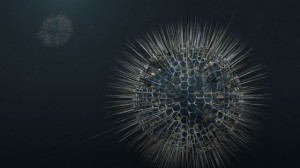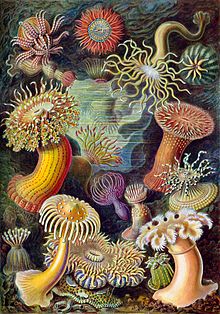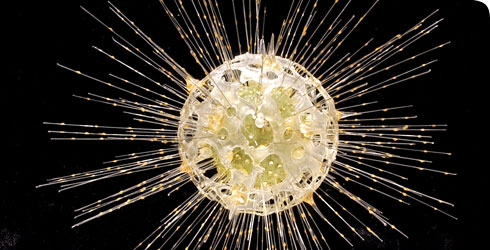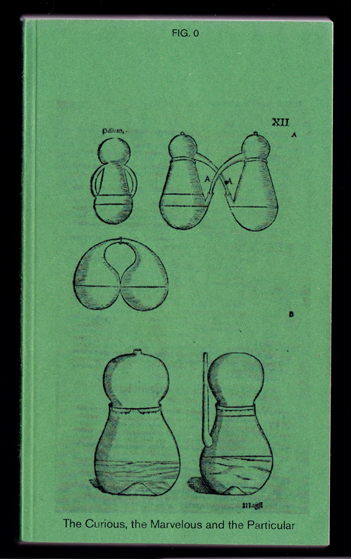In the ocean,  small creatures are swimming around, a form of zooplankton they are, called radiolarians. The name zooplankton is derived from the Greek word ”zoon”, which means animal, and ”planktos”, which means ”wanderer” or ”drifter”, a drifting animal. Individual radiolarians are normally smaller than a hundredth of a millimeter, but some reach the size of a full millimeter or even more which makes it possible to see them with the naked eye. Some species are holding onto each other in a group and may reach a total size of a centimeter and even meter scale all together. The remains of the radiolarian skeleton cover large parts of the ocean bottom and works as radiolarian ooze. The shells of the radiolarians when they die, sinks to the bottom of the ocean, and over time, if enough shells sink together, their skeletal remains become sedimentary rock.
small creatures are swimming around, a form of zooplankton they are, called radiolarians. The name zooplankton is derived from the Greek word ”zoon”, which means animal, and ”planktos”, which means ”wanderer” or ”drifter”, a drifting animal. Individual radiolarians are normally smaller than a hundredth of a millimeter, but some reach the size of a full millimeter or even more which makes it possible to see them with the naked eye. Some species are holding onto each other in a group and may reach a total size of a centimeter and even meter scale all together. The remains of the radiolarian skeleton cover large parts of the ocean bottom and works as radiolarian ooze. The shells of the radiolarians when they die, sinks to the bottom of the ocean, and over time, if enough shells sink together, their skeletal remains become sedimentary rock.
These drifting animals have been a great inspiration in creative fields. They look almost non earthly, both peculiar and beautiful and works as sorts of readymades from nature. An important person in the mapping of the radiolarians is a german biologist called Ernst Haeckel. He named around 150 species during his lifetime. More than a biologist he was also a philosopher, physician and an artist. I find this combination of working fields interesting and the story of Haeckel links to the beauty in science exhibition that is running at the museum Boymans van Beuningen this year. In year 1904 Heackel published a volume called Kunstformen der Natur, which consists of his 100 best prints of organisms from the sea, many of them first described by Heackel himself. Heackels work is a proof for that science and art can operate side by side and that they inevitable borrow from each others world.
It is not only Heackel  that has been inspired by radiolarians. There are music pieces composed, architectural work and there is even a whole art genre named radiolarian art.
that has been inspired by radiolarians. There are music pieces composed, architectural work and there is even a whole art genre named radiolarian art.
It is indeed something special about the planktons. Their structure is a living proof for that the more even a geometrical structure is, the more solid a construction will be. The shell which is made out of silica, also used when making glass, is inspiring for material oriented people. Radiolarians pattern have been casted and used over and over again and my conclusion is that reality and what reality offers is a fascinating subject and a good design and art recipe.
Radiolarians looks as if they were born out of pure imagination and they make me think of cells from a body, about the depth of the see and of universe in its whole. I get the same feeling as I got at the Boymans-exhibition when looking at a picture of the universe. It made me think how very surreal it is that we live inside that picture, now I think how very surreal it is that us living things, built out of small details, living in that big picture. The picture of the universe made me think about how we so badly want to understand why and about our need of decoding our reality and I suggested that religion, science and art works with the same questions but with different approaches, and now I think it is fascinating that when zooming out and when zooming in, the same magic occurs.
And then I wonder. Why did the picture of the universe got my attention in first place. And why do I react the same way on radiolarians? Not many other creatures inspire in the same way, i haven’t heard about rabbit art for example, or shark art. And why is that? My conclusion is because of the esthetics and because we are forced to leave our everyday proportions. It is actually purely the look of the radiolarian that was interesting to start with, I assume it was the beauty that made Haeckel treat radiolarians in artistic ways. The beauty, not the function they have, or history or further anecdote. It makes me think how important esthetic actually is? Is the magic I try to describe beauty? And is actually the good art and design recipe beauty? Would the radiolarians be interesting if looking like potatoes? I don’t think so. And what would happen if not needing to zoom in and switch from everyday proportions? Would radiolarians be as interesting if they were in human size laying around on every street?
It is somehow comforting that radiolarians swim in the sea and that stars shines from universe. And in whatever field we are working with, we are striving to find our place somewhere in between. And some make buildings and jewelry and other radiolarian art.


